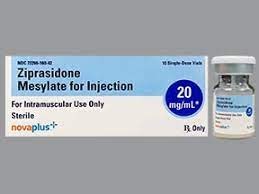A nurse is preparing to administer ziprasidone 10 mg IM every 6 hr. Available is ziprasidone 20 mg/mL. How many mL should the nurse administer per dose? (Round the answer to the nearest tenth. Use a leading zero if it applies. Do not use a trailing zero.)
The Correct Answer is ["0.5"]
To calculate the amount of ziprasidone 10 mg IM from the available concentration of 20 mg/mL, you can use the formula:
Amount (mL) = Desired Dose (mg) / Concentration (mg/mL)
Amount (mL) = 10 mg / 20 mg/mL
Amount (Ml) = 0.5 mL
Therefore, the nurse should administer 0.5 mL of ziprasidone per dose.

Nursing Test Bank
Naxlex Comprehensive Predictor Exams
Related Questions
Correct Answer is C
Explanation
A. Antidepressants usually take several weeks to start taking effect, so the statement "I can be on my antidepressant taking three to five days to be effective" is not correct.
B. While positive thinking can play a role in managing mood, depression is a complex disorder that often requires more than just positive thoughts to treat. The statement "I can cure my depression by thinking positive thoughts" oversimplifies the condition.
C. "I will attend psychotherapy to help manage my depression."
Explanation:
Depressive disorders, including major depression, are complex conditions that typically require a multifaceted approach to treatment. Psychotherapy, also known as talk therapy, is an important component of treating depression. It involves working with a trained therapist to explore and address the thoughts, feelings, and behaviors contributing to the depression. Psychotherapy can help individuals develop coping strategies, improve problem-solving skills, and gain insight into their condition.
D. Depression is not something that can be simply chosen to be stopped voluntarily. It is a mental health disorder that often requires professional treatment and support. The statement "I need to make a voluntary choice to stop feeling depressed" does not accurately capture the nature of depression.
Correct Answer is B
Explanation
A. A client exhibiting psychotic behavior
Group therapy is generally not recommended for clients who are actively exhibiting psychotic behavior. Psychotic behavior can include hallucinations, delusions, and severe thought disturbances, which might impede the individual's ability to effectively participate and benefit from group therapy. Such clients often require more immediate and individualized attention to address their acute symptoms.
B. A client who has been taking amitriptyline for 3 months for depression
This is the correct choice. A client who has been taking amitriptyline for 3 months for depression is likely to have their symptoms more stabilized and under better control compared to acute situations. They might be at a stage where they can engage in group therapy to discuss their experiences, coping strategies, and learn from others in a similar situation.
C. A client who is experiencing alcohol intoxication
Group therapy is not appropriate for clients who are currently intoxicated, as their ability to actively participate and engage in therapeutic discussions may be compromised. Addressing the effects of alcohol intoxication and ensuring the client's safety would be a priority before considering group therapy.
D. A client admitted 12 hours ago for acute mania
Clients admitted for acute mania often require stabilization and intervention to manage their manic symptoms. In the early stages of admission, they might not be in a state conducive to group therapy. Once their acute symptoms are better controlled and they have had time to stabilize, they could potentially benefit from group therapy as part of their overall treatment plan.
Whether you are a student looking to ace your exams or a practicing nurse seeking to enhance your expertise , our nursing education contents will empower you with the confidence and competence to make a difference in the lives of patients and become a respected leader in the healthcare field.
Visit Naxlex, invest in your future and unlock endless possibilities with our unparalleled nursing education contents today
Report Wrong Answer on the Current Question
Do you disagree with the answer? If yes, what is your expected answer? Explain.
Kindly be descriptive with the issue you are facing.
